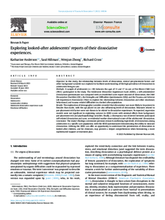Abstract:
Objective
In this study, the relationship between levels of dissociation, several pre-placement factors and other background variables was explored to facilitate understanding of the high prevalence of dissociation in adolescents living in care.
Methods
A sample of adolescents (n = 68) between the ages of 11 and 17 in care at Five Rivers Child Care (FRCC) participated in the study. The Adolescent Dissocitive Experiences Scale (ADES), a self-administered dissociation questionnaire was compared with an established carer-report measure of dissociation, the Child Dissociative Checklist (CDC), the Strengths and Difficulties Questionnaire (SDQ) and the Trauma and Adverse Life Experiences Assessment (TALE) to explore the relationship between dissociation and other emotional, behavioural, and trauma-related difficulties in a looked-after population.
Results
The exploration of demographic variables revealed that dissociation was more likely to be present in females than males, with the age placed in care also influencing levels of dissociation. Measures related to pre-placement risk factors were not shown to be related to dissociative experiences. As expected, regression models were not significant in explaining variance in ADES scores with minimal effects from background, pre-placement risk and psychopathology variables. Finally, a discrepancy was observed between participant self-related dissociation and carer, or residential worker observational scores of the adolescents’ dissociation.
Conclusion
The study's findings corroborate previous research confirming high levels of dissociation among adolescents in a specific care population, with the ADES questionnaire demonstrating the ability to measure dissociation. Utilising the ADES can offer an opportunity to understand the presentation of dissociation in looked-after children, and for clinicians, may provide a deeper comprehension when formulating a more sophisticated support or treatment plan.

